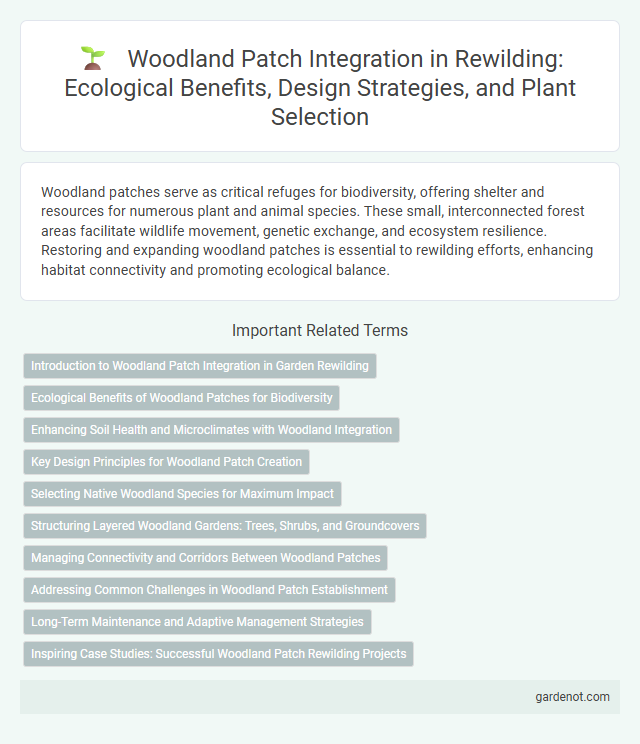Woodland patches serve as critical refuges for biodiversity, offering shelter and resources for numerous plant and animal species. These small, interconnected forest areas facilitate wildlife movement, genetic exchange, and ecosystem resilience. Restoring and expanding woodland patches is essential to rewilding efforts, enhancing habitat connectivity and promoting ecological balance.
Introduction to Woodland Patch Integration in Garden Rewilding
Woodland patch integration in garden rewilding enhances biodiversity by creating microhabitats that support native flora and fauna, such as pollinators and small mammals. Incorporating diverse tree and shrub species establishes ecological corridors that facilitate wildlife movement and improve soil health through natural leaf litter decomposition. This approach fosters resilient ecosystems, promoting carbon sequestration and climate regulation within urban and suburban landscapes.
Ecological Benefits of Woodland Patches for Biodiversity
Woodland patches serve as crucial habitats that support diverse species by providing food, shelter, and breeding grounds, contributing significantly to biodiversity conservation. These patches act as ecological corridors, facilitating species movement and genetic exchange, thereby enhancing ecosystem resilience. Their presence helps maintain soil health and water cycles, promoting overall environmental stability and biodiversity richness.
Enhancing Soil Health and Microclimates with Woodland Integration
Woodland patches play a crucial role in enhancing soil health by increasing organic matter through leaf litter decomposition and root biomass, which improves nutrient cycling and microbial activity. These patches also create diverse microclimates by moderating temperature extremes, increasing humidity, and providing shade that supports a wider range of plant and animal species. Integrating woodland areas within landscapes promotes ecosystem resilience by stabilizing soil structure and fostering beneficial microhabitats essential for rewilding success.
Key Design Principles for Woodland Patch Creation
Woodland patch creation prioritizes ecological connectivity by strategically situating patches to link existing habitats, enhancing wildlife corridors and biodiversity resilience. Incorporating diverse native tree species and structural complexity fosters a multi-layered canopy that supports varied fauna and promotes natural regeneration processes. Soil health improvement and water retention design elements ensure long-term sustainability and adaptability of the woodland ecosystem within rewilding landscapes.
Selecting Native Woodland Species for Maximum Impact
Selecting native woodland species is crucial for effective rewilding, as these plants support local ecosystems by providing habitat and food for indigenous wildlife. Prioritizing species such as oak, birch, and hazel enhances biodiversity and promotes natural regeneration processes. Native woodlands contribute to carbon sequestration, soil health, and water regulation, maximizing ecological and environmental benefits.
Structuring Layered Woodland Gardens: Trees, Shrubs, and Groundcovers
Structuring layered woodland gardens involves strategically planting trees, shrubs, and groundcovers to mimic natural forest ecosystems, enhancing biodiversity and ecological resilience. Trees form the canopy layer, providing shade and habitat, while shrubs create the understory that supports wildlife and plant diversity. Groundcovers establish a protective soil layer that prevents erosion, retains moisture, and fosters a microhabitat for insects and fungi essential to woodland health.
Managing Connectivity and Corridors Between Woodland Patches
Managing connectivity and corridors between woodland patches enhances biodiversity by facilitating wildlife movement and gene flow. Creating buffer zones and restoring native vegetation along corridors improves habitat quality and resilience against fragmentation. Effective corridor management supports ecosystem services, such as pollination and seed dispersal, critical for rewilding success.
Addressing Common Challenges in Woodland Patch Establishment
Woodland patch establishment often faces challenges such as soil degradation, invasive species, and limited biodiversity connectivity. Effective strategies include selecting native species adapted to local conditions, implementing soil restoration techniques, and creating ecological corridors to enhance wildlife movement. Monitoring and adaptive management are essential to ensure long-term resilience and ecosystem functionality in rewilding projects.
Long-Term Maintenance and Adaptive Management Strategies
Woodland patch restoration requires long-term maintenance strategies including controlled grazing, invasive species removal, and regular monitoring of native flora and fauna to ensure ecosystem resilience. Adaptive management involves using data-driven approaches to modify interventions based on ongoing ecological assessments and climate change impacts. Sustained funding and community engagement are critical to support these dynamic management practices and promote biodiversity enhancement.
Inspiring Case Studies: Successful Woodland Patch Rewilding Projects
Woodland patch rewilding projects such as Knepp Estate in Sussex and the Oostvaardersplassen in the Netherlands showcase remarkable ecosystem restoration through natural regeneration and species reintroduction. These case studies demonstrate increased biodiversity, improved soil health, and the return of native flora and fauna within relatively small fragmented habitats. Successful management strategies focus on minimal human intervention, allowing natural processes to drive woodland recovery and sustain diverse wildlife populations.
Woodland patch Infographic

 gardenot.com
gardenot.com